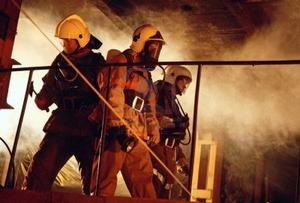First respondersTactile helmet helps first responders in challenging conditions
A specially-adapted “tactile helmet,” developed by researchers at the University of Sheffield, could provide fire-fighters operating in challenging conditions with vital clues about their surroundings. The helmet is fitted with a number of ultrasound sensors which are used to detect the distances between the helmet and nearby walls or other obstacles.

Tactile, sensor-filled helmets will aid firefighters situational awareness // Source: 123rf.com
A specially-adapted “tactile helmet,” developed by researchers at the University of Sheffield, could provide fire-fighters operating in challenging conditions with vital clues about their surroundings.
The helmet is fitted with a number of ultrasound sensors which are used to detect the distances between the helmet and nearby walls or other obstacles. These signals are transmitted to vibration pads that are attached to the inside of the helmet, touching the wearer’s forehead. Rescue workers, such as fire-fighters, who might be working in dark conditions or in buildings filled with smoke, will be able to use the signals to find walls and other obstacles that could help guide them through unfamiliar environments.
A University of Sheffield release reports that it is anticipated that a lightweight version of the technology could also be useful to people with visual impairments, acting as an additional “sense” to guide users or to help them avoid hazards.
Invented by a team of researchers at the Sheffield Center for Robotics (SCentRo), the helmet was inspired by research into tactile sensing in rodents, whose whiskers give early warning of potential hazards.
Professor Tony Prescott of the University of Sheffield and director of SCentRo, said: “When a firefighter is responding to an emergency situation he will be using his eyes and ears to make sense of his environment, trying to make out objects in a smoke filled room, for example, or straining to hear sounds from people who might need rescuing. We found that in these circumstances it was difficult to process additional information through these senses. Using the sense of touch, however, we were able to deliver additional information effectively.”
The team also found that the helmet was the ideal place to locate the vibrating pads because, although the fingertips might seem a more obvious choice, stimuli delivered to the wearer’s forehead enabled them to respond more rapidly to the signals, and would also leave their hands free for other tasks.
The release notes that the prototype helmet was developed using a Rosenbauer helmet donated by Northfire Ltd. and was produced following a two-year research project, funded by the U.K. Engineering and Physical Sciences Research Council.
South Yorkshire Fire and Rescue Service have also assisted, providing advice during the development period as well as access to their training facility. The next step is to find a commercial partner interested in further developing the helmet.
The helmet will be on show at this year’s Gadget Show Live, to be held at the NEC in Birmingham on 3-7 April 2013.
